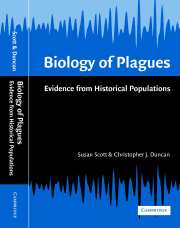Book contents
- Frontmatter
- Contents
- Preface
- Conversion table for imperial to metric units
- 1 Introduction
- 2 Epidemiological concepts
- 3 The biology of bubonic plague
- 4 The Great Pestilence
- 5 Case study: the plague at Penrith in 1597–98
- 6 Pestilence and plague in the 16th century in England
- 7 Plagues in the 16th century in northern England: a metapopulation study
- 8 Plagues in London in the 17th century
- 9 Plagues in the provinces in the 17th century
- 10 Plague at Eyam in 1665–66: a case study
- 11 Continental Europe during the third age of plagues: a study of large-scale metapopulation dynamics
- 12 The plague at Marseilles, 1720–22: an outbreak of bubonic plague?
- 13 Conclusions
- References
- Index
3 - The biology of bubonic plague
Published online by Cambridge University Press: 28 October 2009
- Frontmatter
- Contents
- Preface
- Conversion table for imperial to metric units
- 1 Introduction
- 2 Epidemiological concepts
- 3 The biology of bubonic plague
- 4 The Great Pestilence
- 5 Case study: the plague at Penrith in 1597–98
- 6 Pestilence and plague in the 16th century in England
- 7 Plagues in the 16th century in northern England: a metapopulation study
- 8 Plagues in London in the 17th century
- 9 Plagues in the provinces in the 17th century
- 10 Plague at Eyam in 1665–66: a case study
- 11 Continental Europe during the third age of plagues: a study of large-scale metapopulation dynamics
- 12 The plague at Marseilles, 1720–22: an outbreak of bubonic plague?
- 13 Conclusions
- References
- Index
Summary
Humans have been afflicted by bubonic plague for hundreds of years, particularly in central Asia and China, where it is endemic, and epidemics have flared up at sporadic intervals when the conditions are right. Localised outbreaks have been described in ports in England in the 20th century and there are a number of reports of ships coming from the East on which bubonic plague was diagnosed in crew members. Heavy mortality can be experienced over long periods of time: 12 million people died of bubonic plague in India between 1898 and 1957. Bubonic plague is a lethal infection of rats that is spread to humans via the rat flea when environmental and other conditions are suitable. The biology and epidemiology of the disease was only fully elucidated at the end of the 19th century and, because some of its clinical features were recorded in contemporaneous reports of the Black Death, 20th century accounts, almost without exception, give bubonic plague as the disease causing that pandemic. It is, therefore, important to describe the biology of bubonic plague in detail before accepting it as the cause of the Black Death and other subsequent plagues in England up to 1665. Christie (1969), who had wide experience of infectious diseases, has provided an admirable account of the epidemiology of modern bubonic plague and the following pages are very much based on his overview.
- Type
- Chapter
- Information
- Biology of PlaguesEvidence from Historical Populations, pp. 47 - 80Publisher: Cambridge University PressPrint publication year: 2001



